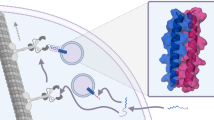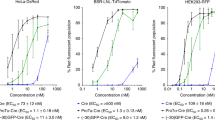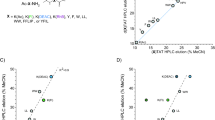Abstract
We designed and synthesized small-molecule mimics of an alpha-helical peptide protein transduction domain (PTD). These small-molecule carriers, which we termed SMoCs, are easily coupled to biomolecules, and efficiently deliver dye molecules and recombinant proteins into a variety of cell types. We designed the SMoCs using molecular modeling techniques. As an example of a protein cargo, we applied this new technology to the internalization of the DNA replication licensing repressor geminin, in vitro, providing evidence that extracellularly delivered SMoC-geminin can have an antiproliferative effect on human cancer cells. Uptake of SMoC-geminin was inhibited at 4 °C and by chlorpromazine, a compound that induces misassembly of clathrin-coated pits at the cell surface. Thus the mechanism of uptake is likely to be clathrin-mediated endocytosis.
This is a preview of subscription content, access via your institution
Access options
Subscribe to this journal
Receive 12 print issues and online access
$259.00 per year
only $21.58 per issue
Buy this article
- Purchase on Springer Link
- Instant access to full article PDF
Prices may be subject to local taxes which are calculated during checkout





Similar content being viewed by others
References
Bonetta, L. Getting proteins protein into cells. Scientist 16, 38–40 (2002).
Roberts, J.P. Buyer's guide to protein transduction reagents - A range of chemicals and peptides are available to help get proteins into cells. Scientist 18, 42–43 (2004).
Wadia, J.S. & Dowdy, S.F. Transmembrane delivery of protein and peptide drugs by TAT-mediated transduction in the treatment of cancer. Adv. Drug Deliv. Rev. 57, 579–596 (2005).
Joliot, A. & Prochiantz, A. Transduction peptides: from technology to physiology. Nat. Cell Biol. 6, 189–196 (2004).
Morris, M.C., Depollier, J., Mery, J., Heitz, F. & Divita, G. A peptide carrier for the delivery of biologically active proteins into mammalian cells. Nat. Biotechnol. 19, 1173–1176 (2001).
Schwarze, S.R., Ho, A., Vocero-Akbani, A. & Dowdy, S.F. In vivo protein transduction: delivery of a biologically active protein into the mouse. Science 285, 1569–1572 (1999).
Li, T., Fan, Y., Luo, Y., Xiao, B. & Lu, C. In vivo delivery of a XIAP (BIR3-RING) fusion protein containing the protein transduction domain protects against neuronal death induced by seizures. Exp. Neurol. 197, 301–308 (2006).
Choi, H.S. et al. Transduced Tat-α-synuclein protects against oxidative stress in vitro and in vivo. J. Biochem. Mol. Biol. 39, 253–262 (2006).
Cashman, S.M., Morris, D.J. & Kumar-Singh, R. Evidence of protein transduction but not intercellular transport by proteins fused to HIV tat in retinal cell culture and in vivo. Mol. Ther. 8, 130–142 (2003).
McGarry, T.J. & Kirschner, M.W. Geminin, an inhibitor of DNA replication, is degraded during mitosis. Cell 93, 1043–1053 (1998).
Magzoub, M., Eriksson, L.E. & Graslund, A. Conformational states of the cell-penetrating peptide penetratin when interacting with phospholipid vesicles: effects of surface charge and peptide concentration. Biochim. Biophys. Acta 1563, 53–63 (2002).
Futaki, S. et al. Arginine-rich peptides. An abundant source of membrane-permeable peptides having potential as carriers for intracellular protein delivery. J. Biol. Chem. 276, 5836–5840 (2001).
Shibata, A. et al. Synthetic copoly(Lys/Phe) and poly(Lys) translocate through lipid bilayer membranes. Biochim. Biophys. Acta 1616, 147–155 (2003).
Ho, A., Schwarze, S.R., Mermelstein, S.J., Waksman, G. & Dowdy, S.F. Synthetic protein transduction domains: enhanced transduction potential in vitro and in vivo. Cancer Res. 61, 474–477 (2001).
Orner, B.P., Ernst, J.T. & Hamilton, A.D. Toward proteomimetics: terphenyl derivatives as structural and functional mimics of extended regions of an α-helix. J. Am. Chem. Soc. 123, 5382–5383 (2001).
Kutzki, O. et al. Development of a potent Bcl-x(L) antagonist based on α-helix mimicry. J. Am. Chem. Soc. 124, 11838–11839 (2002).
Jacoby, E. Biphenyls as potential mimetics of protein α-helix. Bioorg. Med. Chem. Lett. 12, 891–893 (2002).
Rothbard, J.B., Jessop, T.C. & Wender, P.A. Adaptive translocation: the role of hydrogen bonding and membrane potential in the uptake of guanidinium-rich transporters into cells. Adv. Drug Deliv. Rev. 57, 495–504 (2005).
Wohlschlegel, J.A. et al. Inhibition of eukaryotic DNA replication by geminin binding to Cdt1. Science 290, 2309–2312 (2000).
Okorokov, A.L. et al. Molecular structure of human geminin. Nat. Struct. Mol. Biol. 11, 1021–1022 (2004).
Nunn, C.M. et al. Crystal structure of tobacco etch virus protease shows the protein C terminus bound within the active site. J. Mol. Biol. 350, 145–155 (2005).
Kulartz, M. & Knippers, R. The replicative regulator protein geminin on chromatin in the HeLa cell cycle. J. Biol. Chem. 279, 41686–41694 (2004).
Wang, L.H., Rothberg, K.G. & Anderson, R.G. Mis-assembly of clathrin lattices on endosomes reveals a regulatory switch for coated pit formation. J. Cell Biol. 123, 1107–1117 (1993).
Rothberg, K.G. et al. Caveolin, a protein component of caveolae membrane coats. Cell 68, 673–682 (1992).
West, M.A., Bretscher, M.S. & Watts, C. Distinct endocytotic pathways in epidermal growth factor-stimulated human carcinoma A431 cells. J. Cell Biol. 109, 2731–2739 (1989).
Sampath, P. & Pollard, T.D. Effects of cytochalasin, phalloidin, and pH on the elongation of actin filaments. Biochemistry 30, 1973–1980 (1991).
Murray, J.W. & Wolkoff, A.W. Roles of the cytoskeleton and motor proteins in endocytic sorting. Adv. Drug Deliv. Rev. 55, 1385–1403 (2003).
Stoeber, K. et al. Cdc6 protein causes premature entry into S phase in a mammalian cell-free system. EMBO J. 17, 7219–7229 (1998).
Kingsbury, S.R. et al. Repression of DNA replication licensing in quiescence is independent of geminin and may define the cell cycle state of progenitor cells. Exp. Cell Res. 309, 56–67 (2005).
Richard, J.P. et al. Cellular uptake of unconjugated TAT peptide involves clathrin-dependent endocytosis and heparan sulfate receptors. J. Biol. Chem. 280, 15300–15306 (2005).
Acknowledgements
We thank Mitsubishi Pharma Corporation for a visiting fellowship for M.O. and funding for C.V.; HL was funded by the Association for International Cancer Research. We are grateful to A. Okorokov for advice on the generation of geminin loss-of-function mutants and the ΔNt-geminin construct, and to S. Djordjevic for the gift of pRET 3a-TEV plasmid. We thank A. Stuart for advice on inhibitors of pathways of endocytosis and H. Engel for technical assistance. We thank A. Farshchi and S. Paige for technical assistance with site-directed mutagenesis and protein expression. We are grateful to L. Rakes and L. Suarez-Delgado for assistance with cell-proliferation assays. The geminin studies were funded by Cancer Research UK Programme Grant C428/A6263. S.R.K. is supported by an MRC Research Studentship.
Author information
Authors and Affiliations
Contributions
M.O. and D.L.S., chemical design and molecular modeling; M.O. and C.V. chemical synthesis; H.L., C.B. and E.L., studies on transport of dyes and SMoCs into cells; H.L. and E.L., studies on mechanism of uptake; S.R.K., K.L.E., K.S. and G.H.W., coupling of geminin to SMoCs and studies on antiproliferative action of SMoC geminin.
Corresponding authors
Ethics declarations
Competing interests
M.O. was funded as a visiting researcher by Mitsubishi Pharma, and C.V. was funded by Mitsubishi Pharma for one year. The university has filed a patent, WO2005123676(A1), on this work. The authors may eventually received financial reward through a university revenue sharing scheme.
Supplementary information
Supplementary Fig. 1
Influence of chemical inhibitors on uptake of SMoC.
Supplementary Fig. 2
Inhibition of G0-S progression with SMoC-geminins.
Rights and permissions
About this article
Cite this article
Okuyama, M., Laman, H., Kingsbury, S. et al. Small-molecule mimics of an α-helix for efficient transport of proteins into cells. Nat Methods 4, 153–159 (2007). https://doi.org/10.1038/nmeth997
Received:
Accepted:
Published:
Issue Date:
DOI: https://doi.org/10.1038/nmeth997
This article is cited by
-
In vitro neurogenesis: development and functional implications of iPSC technology
Cellular and Molecular Life Sciences (2014)
-
Progress and Promise Towards Safe Induced Pluripotent Stem Cells for Therapy
Stem Cell Reviews and Reports (2010)
-
For protein transduction, chemistry can win over biology
Nature Methods (2007)



